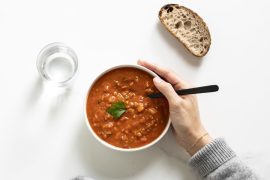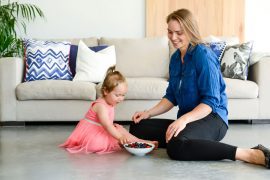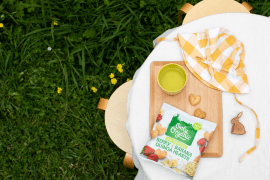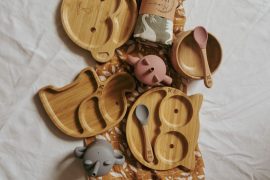Scene 3, four months after Jack’s birth: Jack is being held in a sitting position facing outwards on his father’s lap while his parents eat spaghetti bolognese. He watches as his mother and father twirl their spaghetti and lift it to their mouths, and he waves his arms excitedly. He reaches out towards his dad’s plate and gives the pile of pasta and sauce a hefty smack. He has made the acquaintance of his first solid food!
Scene 4, five months after Jack’s birth: Jack is being held in a sitting position facing outwards on his mother’s lap while his parents eat a roast dinner. He watches as his mother lifts food to her mouth and he tries to grab her hand. She puts some sticks of carrot on the table top in front of him. Jack looks at them, pushes them around, then picks one up, squeezes it, turns it over – then drops it. He picks up another and gets it to his mouth, where he explores it with his lips and tongue. Then he drops that one too. He has experienced a new taste and an interesting texture – but he hasn’t eaten anything.
Scene 5, six months after Jack’s birth: Jack is sitting in a high chair, with a rolled-up towel behind him for support. His parents are eating a chicken casserole. Jack’s mother puts a piece of potato, a broccoli floret and a chicken drumstick on his tray. Jack has a go at all three, doing a lot of squishing, squashing and banging, and occasionally biting off small amounts which he chews and then allows to fall out of his mouth. He has a great time, even though he doesn’t swallow anything.
Scene 6, seven months after Jack’s birth: Jack is sitting in his high chair, sharing a meal of bread, avocado, cheese and fruit with his parents. His mother comments to his father that the smell of Jack’s poo has changed recently, and she can definitely make out bits of partly-digested food in his nappies. They try unsuccessfully to work out at which recent meal Jack swallowed his first mouthful. They conclude that it doesn’t really matter – he’s healthy, he’s making progress and he’s having fun.
So, did Jack’s parents ‘start’ him on solid foods or did Jack ‘start solids’ himself? And when, exactly, did this happen? Not easy, is it? The fact is that the word ‘start’ is almost meaningless in this context: BLW parents don’t choose when to start their babies on solids, they just decide when to begin providing the opportunity for them to do this themselves.
In theory, we could begin to provide this opportunity any time from birth onwards. However, there is a risk to saying it’s OK to ‘start’ BLW earlier than six months. If parents don’t fully understand the theory that underpins the BLW approach they may not appreciate that ‘meeting’ comes before ‘eating’. This can lead them (or their well-meaning relatives) to ‘help’ their baby to eat when she is not really ready, for example by putting food into her mouth for her. Once control is taken away from the baby, BLW ceases to work – and the risks of choking and over-feeding are increased.
Since we now have good scientific evidence that breastmilk is all most babies need until they are around six months old, and since most won’t actually eat anything solid before that, even if they are given the opportunity, it seems reasonable to stick to six months as the best age to start.










